SWOT analysis
Create a SWOT analysis and turn it into actionable strategies
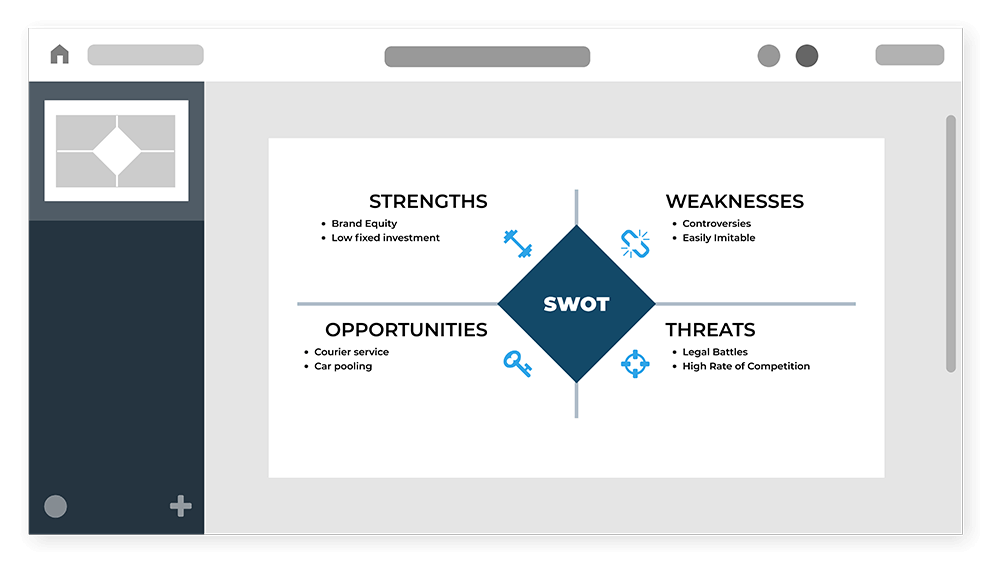
Every business venture comes with an inherent risk of failure. Will your product be successful? Will your target market actually want what you’re selling? These are the types of questions that keep entrepreneurs up at night. But with strategic planning and execution, that risk can be minimized. And one way to do that is to create a SWOT analysis.
AS SEEN ON:




What is a SWOT analysis?
SWOT analysis — strengths, weaknesses, opportunities and threats
Most people have heard of SWOT analysis, but what exactly is it? What is the purpose of a SWOT analysis? SWOT stands for Strengths, Weaknesses, Opportunities, and Threats.
In other words, it’s a framework used to evaluate a company’s competitive position and to develop strategic planning and ideas for the future. SWOT analysis assesses internal and external factors, as well as current and future potential.
The Strengths and Weaknesses belong to the internal environment, factors which occur within a company. So for example you have to take into account areas such as financial, physical and human resources, and current processes.
On the other hand, the Opportunities and Threats relate to the external environment, forces which influence and affect a company from outside. So for example you have to take into consideration the latest market trends, stakeholders and other factors that might not be under your immediate control.
By taking all of these factors into account, businesses can develop strategies that take advantage of strengths, address weaknesses, seize opportunities, and avoid threats. So the next time you’re in a meeting and someone starts talking about SWOT analyses, you’ll know exactly what they’re talking about!
While it’s mostly used in the business world, personal SWOT analyses are also a thing. You can use a SWOT matrix to address your personal development journey. Let’s take an example. If one of your goals is to wake up every day at 5 am but can’t pull it off, a SWOT analysis can help you find new strategies to reach your goal.
All in all, it’s an awesome tool if you want to reach business and personal goals.
Another popular acronym might help you here: PEST Analysis – which stands for political, economic,
social-ecological and technological environment. A good PEST analysis may help you discover and evaluate the macro environment, and as such can be an essential tool to identify external factors in a successful SWOT analysis.
SWOT
Strengths
This element identifies internal areas where a company has a strong competitive advantage compared with its competitors. A great place to start is to simply ask yourself: What does our company do well?
Weaknesses
This is the stage where a company has to be honest and admit its weak points compared to its competitors. What do your competitors do better than you? The ability to identify the weaknesses within a company is the first step to minimising the negative consequences for the performance of a company.
Opportunities
Firstly consider positive circumstances which could influence your company. It’s essential that a company is always on the look out for external opportunities and takes advantage of them. The ability to correctly spot new trends early can bring huge success.
Threats
Unfortunately, the external environment can deliver negative news as well. This part of the analysis will hopefully reveal any potential dangers for your company and offer a chance to minimize or even avoid these threats with early action.
Why Is SWOT Analysis So Vital For Your Business?
1. It Helps Build Agility
Any business owner worth their salt knows that adaptability is key to success. After all, the world is always changing, and those who can’t change with it are bound to be left behind.
To evolve, you need to be aware of your strengths. And of your Achilles heel. 🗡️
That’s where SWOT analysis comes in. The 4 key factors of this analysis can help you identify areas of your business that need improvement. In addition, you can capitalize on opportunities.
This input can then be used to make strategic decisions that will help your business become more adaptable and better able to weather any storms that come its way. So if you’re looking to give your business a competitive edge, don’t forget the power of a SWOT analysis.
2. The SWOT Framework Helps You Allocate Resources Wisely
The SWOT framework is a simple, yet powerful tool for businesses to use when deciding how to allocate resources.
Successful businesses don’t have infinite resources, they just know how to use them wisely.
So, you can create a SWOT analysis to develop a clear plan for how to best use resources. For example, if your biggest strength lies in customer service, you can focus on investing in resources that make the customer experience even more memorable. ✨
Or, if your biggest threat is competition from low-cost providers, you can invest in developing strategies that help your company differentiate itself in the market.
3. It Gives You a Competitive Edge
Those who know their business inside and out are best equipped to make it to the top.
If you create a SWOT analysis, you have the chance of understanding your company’s position in the industry by analyzing external factors such as opportunities. Of course, it’s up to you to figure out how to make use of your competitive advantage, but regular analyses will bring out new growth opportunities.
4. It Improves Business Operations
The SWOT matrix allows business professionals to analyze internal factors such as weaknesses within the company. And it forces you to look objectively at your business.
All too often, business owners get caught up in the day-to-day grind and lose sight of the bigger picture. By sitting down and taking stock of all four SWOT factors, business owners can get a much better sense of what is working well and what needs improvement.
It’s a great tool for improving business operations.
Specific Uses of SWOT Analysis
SWOT analysis can be used by businesses of all sizes. If you were wondering how you can use this framework specifically, we’ve compiled a list of the most common uses of SWOT analysis in business:
Brand SWOT Analysis
Did you know that you can use a SWOT analysis to develop your brand, rebrand, or evaluate brand consistency?
Yep, it’s true. All you have to do is adapt the analysis to your branding needs.
This brand SWOT analysis takes a look at a brand’s reputation, to find ways to improve it.
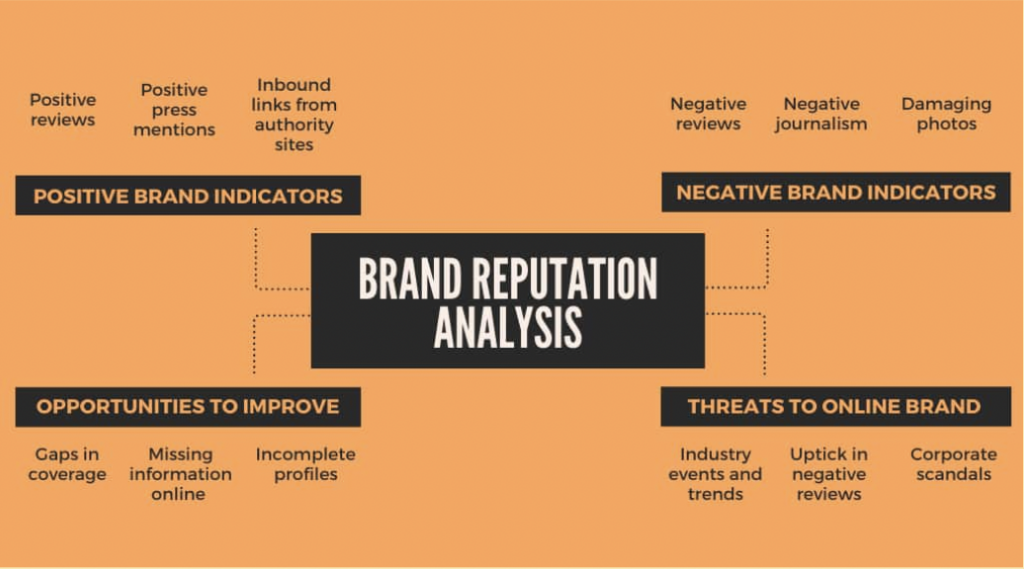
You can apply the same principle if you want to improve brand consistency, or brand awareness, for that matter.
Marketing SWOT Analysis
You can even use this analysis to develop a marketing strategy or to find new marketing opportunities.
Here are a few questions you can ask to uncover the 4 factors of the marketing SWOT analysis:
- How can we reach our marketing goals by using our strengths? (strengths)
- What tools or strategies do we have on deck to reach this goal? (strengths)
- What differentiates us? (strengths)
- What could we improve in our marketing game? (weaknesses)
- What are our limitations? (weaknesses)
- What trends could we use to our advantage? (opportunities)
- What tactics aren’t our competitors using? (opportunities)
- What is our competition doing better than us? (threats)
Competitor SWOT Analysis
Like it or not, to reach the top you need to peek into what your competitors are doing. A competitor SWOT analysis can help you understand the success or failure of other companies, be they, competitors or models.
It’s a powerful tool in that sense because it can help entrepreneurs have a peek at their competitors’ strengths and weaknesses. Who knows, if you do it right, you might discover some untapped opportunities for your business or brand.
Financial SWOT analysis
A financial SWOT analysis, as the name suggests, is a tool that can be used to assess the financial health of a business.
When you create a SWOT analysis for analyzing financial goals, you can take into account several factors, including income, expenses, debts, assets, and liabilities. By looking at all of these factors, the financial SWOT analysis can help identify areas of financial strength and weakness. It can also be used to develop an action plan for addressing financial challenges.
While the financial SWOT analysis can be helpful for businesses of all sizes, it can be especially useful for small businesses. These companies may not have the resources to hire a financial advisor.
With its easy-to-use format, financial SWOT analysis is a valuable tool that any business owner can use to make informed decisions about their financial future.
How to Create a Good SWOT Analysis for Your Business
As we’ve seen, swotting up your business is always a good idea. It’s not navel-gazing.
It’s all about knowing your business, with its Strengths, Weaknesses, Opportunities, and Threats – inside out, to grow.
But how do you create a SWOT analysis that gets results? 🤔
We got you covered! Improving your business will feel like a breeze with these 7 SWOT analysis tips:
1. Gather Your Tribe
While the SWOT matrix can be completed by just one person, it is advisable to gather a few people in your company.
More people with different backgrounds and experiences bring cognitive diversity to the table. Which is key when it comes to innovation and problem-solving.
2. Find an Objective
Any analysis or planning process starts with a goal. So, before you start brainstorming opportunities or writing down the weaknesses of your business, it’s best to have your goal in mind.
Make sure that you choose a S.M.A.R.T goal, meaning one that is specific, measurable, attainable, realistic, and time-bound.
3. Research, Research, Research
Before you create a SWOT analysis for your company, we’d suggest diving into deep research about your business, industry, and market.
You can gain a greater understanding of your business in many different ways. Market research, focus groups, competitive analysis, and discussion with partners or employees are just a few of them.
4. Evaluate the External Factors of Your Business
Any SWOT diagram looks at external factors and internal factors. We’d suggest looking at external factors first and foremost, as these can have a profound impact on internal business factors.
External factors can be things like the economy, changes in government regulation, or even shifts in consumer spending patterns. Once you’ve identified these factors, you can begin to assess how they might impact your business. This will help you to develop a plan of action to maximize opportunities and minimize threats.
5. Determine Your Business’ Strengths and Weaknesses
The next step would be to analyze the strengths and weaknesses of your business. This way, when you look back at your SWOT analysis, you will figure out with ease whether the weaknesses were resolved and if you capitalized on the strengths.
6. Find Opportunities
Now that you’re done with the SWOT analysis, you can discuss with your team which objectives are worth pursuing.
7. Prioritize and Create Timeframes
The analysis might reveal a long list of opportunities for your business. Don’t panic! The list just needs a bit of structure.
So, gather your team and brainstorm. Which of the objectives should be prioritized? Make a list. For each one, set a timeframe.
You’ll progress faster this way.
8. Turn the SWOT Into Actionable Strategies
Each goal can usually be achieved in different ways. Which is the most efficient? What resources do you have on deck?
To find the right strategies, you can make use of a TOWS matrix, which is derived from the SWOT analysis model. The letters of TOWS stand for a different arrangement of the word SWOT — threats, opportunities, weaknesses, and strengths.
This tool is used to generate, compare and select strategies after a SWOT analysis, and helps to define a strategic plan of action for future years.
The four TOWS strategies are Strength/Opportunity (SO), Weakness/Opportunity (WO), Strength/Threat (ST), and Weakness/Threat (WT).
SO strategies
If you want to define an SO strategy, you need to ask yourself which of your company’s strengths can be used to maximize the opportunities identified.
WO strategies
The purpose of a WO strategy is to find out how to minimize or eliminate the company’s weaknesses by using the opportunities identified in the SWOT analysis.
ST strategies
When it comes to an ST strategy you need to think about how to use the company’s strengths to minimize the threats.
WT strategies
The last strategy considers weaknesses and threats. In this case, you need to figure out how to minimize the company’s weaknesses and avoid threats.
SWOT analysis template
You can customize every detail about your SWOT analysis, from fonts to text colors, text size, lines, background etc.
But maybe you don’t have advanced design skills to create a SWOT diagram. No problem. We got you covered.
With Xara’s templates, you’ll be able to create a SWOT analysis in no time. Ready to grow your business?
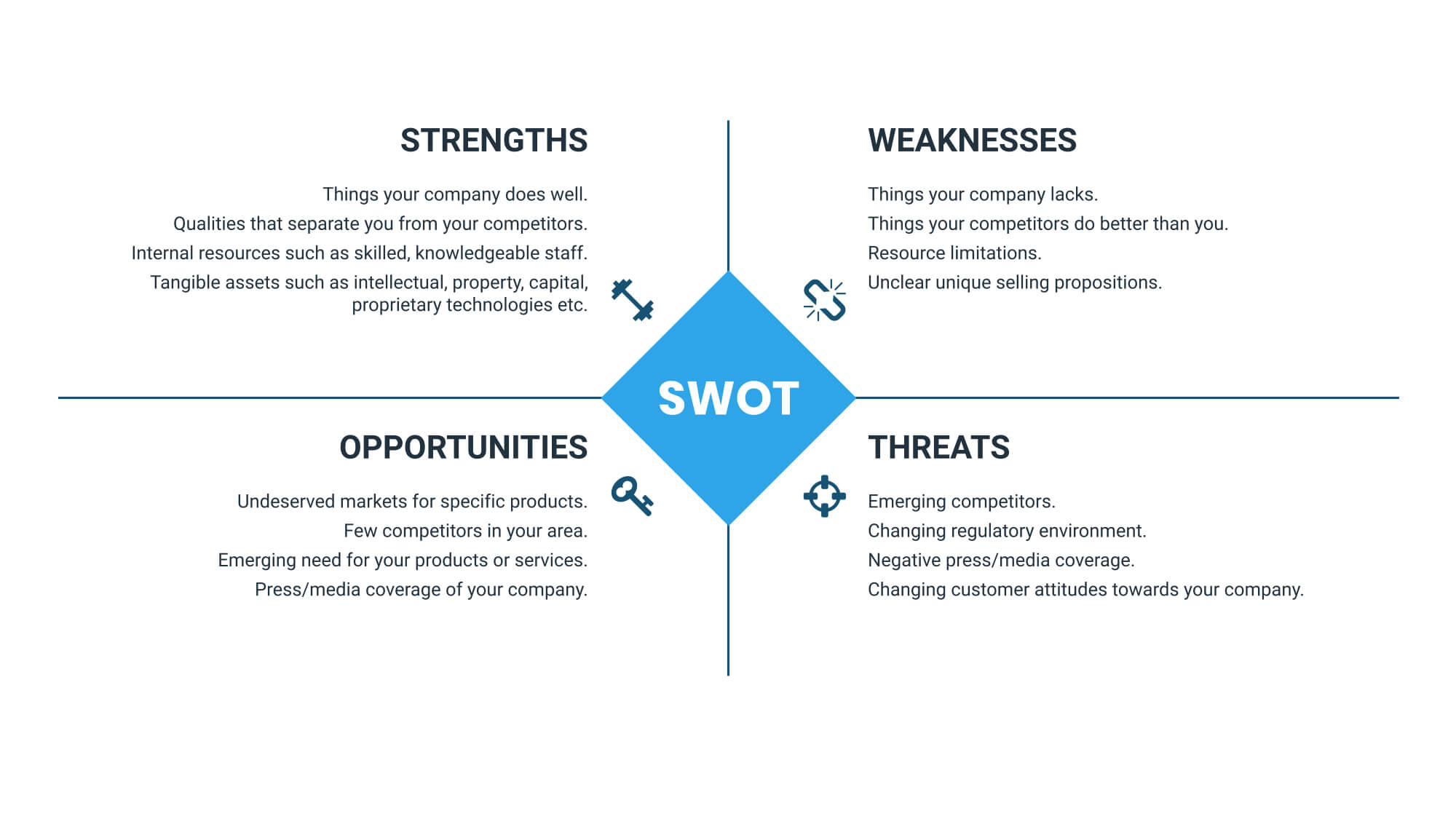
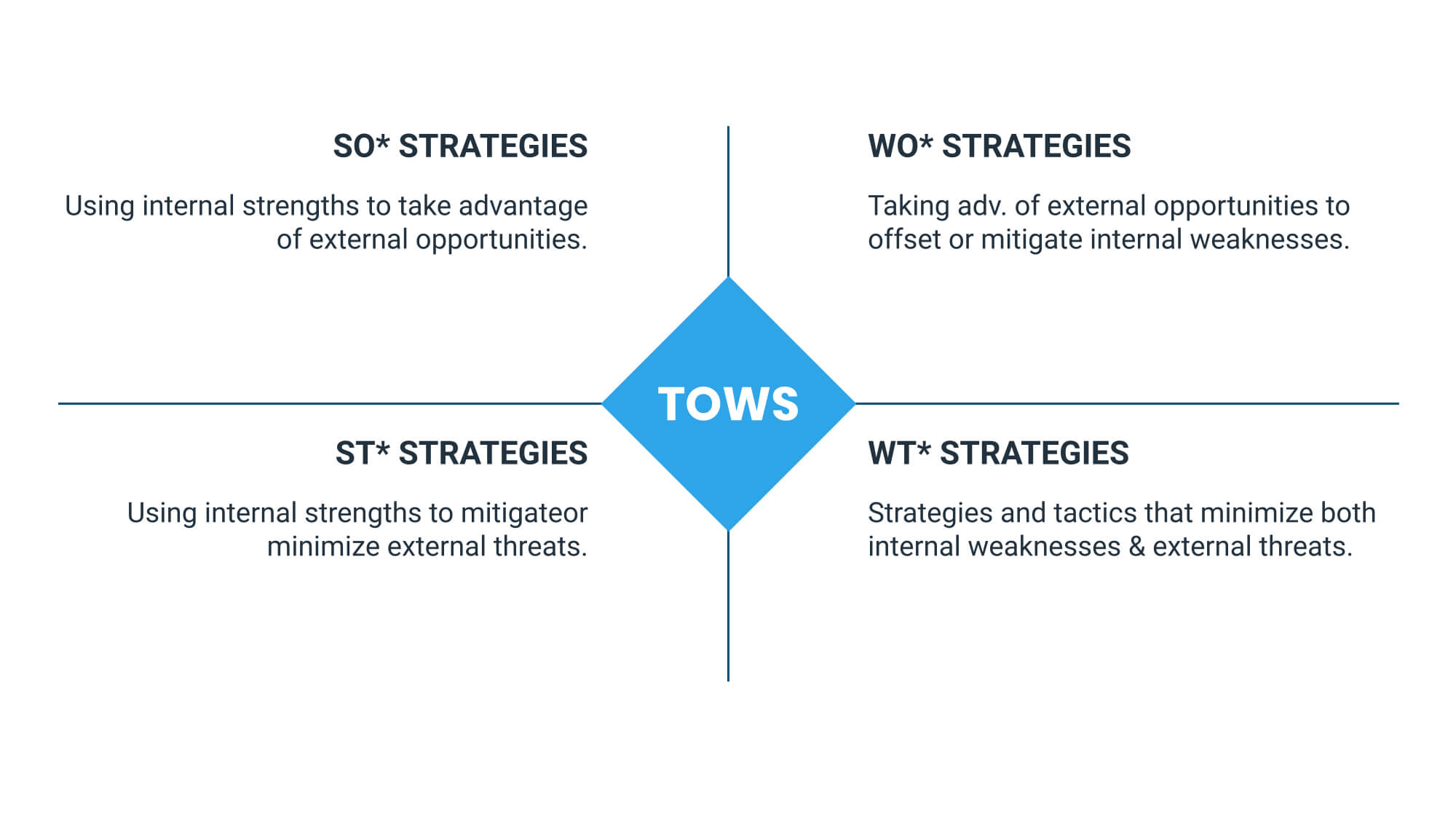
SWOT Analysis Examples
If you need an extra dose of inspiration, we’ve created these SWOT analysis examples using Xara’s templates. Take a look:
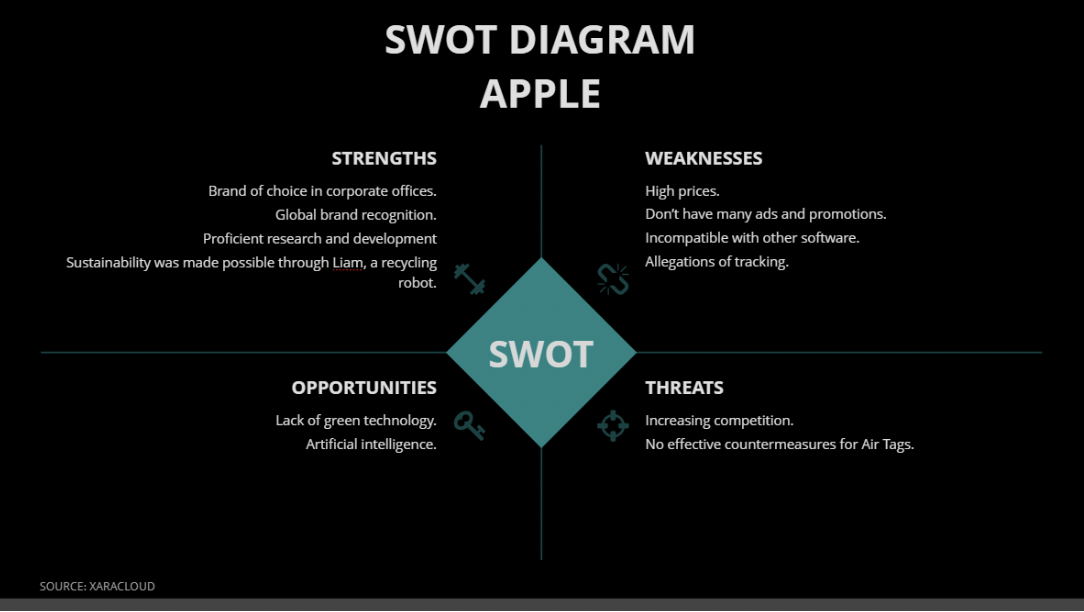
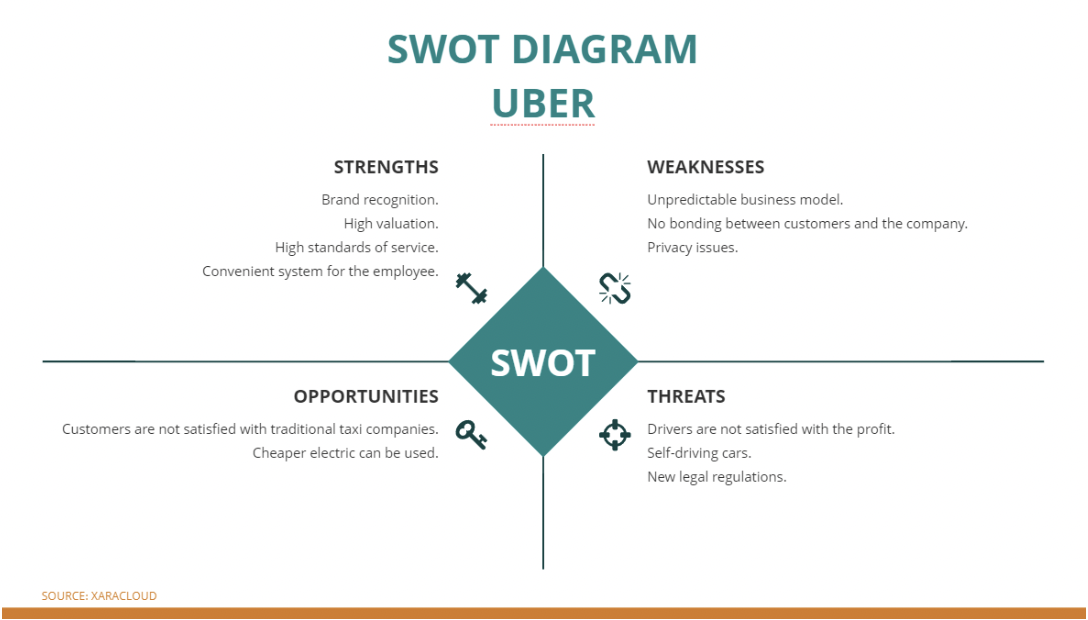
The SWOT Analysis: a Powerful Business Tool
When you create a SWOT analysis, content is king, for sure. 👑
But you also need an impactful design.
The identified factors can be made memorable by using an eye-catching design. And if you plan to present your SWOT matrix to stakeholders, you need a professional and sleek design.
However, not everyone knows their way around design. With Xara, that’s not a problem. Xara offers a wide range of SWOT analysis templates that you can use. You can personalize these templates according to your requirements, including auto-applying a color palette from your chosen image or brand, and automatically inserting the brand’s logo or fonts.
If you want your SWOT analysis templates to stand out, start your Xara free trial now and play around. Your SWOT diagrams will be attention-grabbing, that’s for sure.
